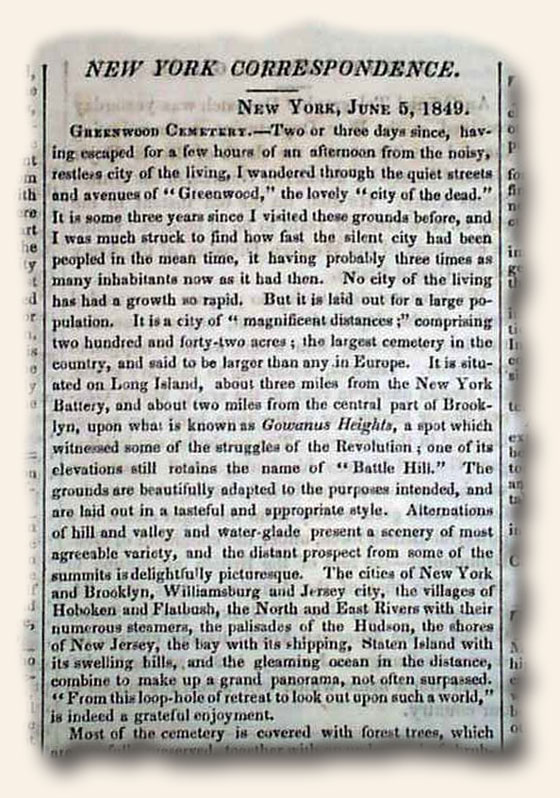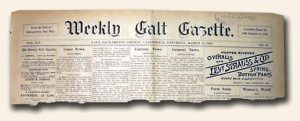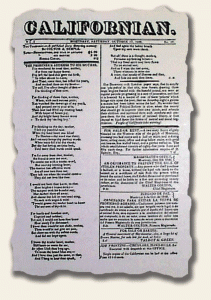A common thread…
September 22, 2014 by GuyHeilenman · Leave a Comment
Question: What do Henry Ward Beecher (abolitionist), Leonard Bernstein (composer/conductor), Henry Bergh (founder of the A.S.P.C.A), Charles Ebbets (owner, Brooklyn Dodgers), “Boss” Tweed (NY political boss), Henry Steinway (founder of Steinway & Sons, piano manufacturers), and Samuel F.B. Morse (inventor of the Morse code) have in common?
Answer: They, along with many other equally famous, infamous, and relatively unknown individuals are currently resting in Greenwood Cemetery, Brooklyn, New York – it being among the most noteworthy cemeteries in the United States. A scan over the list of those buried at this single location is quite sobering – causing one to pause and consider the hope for something beyond the grave.
What inspired the above query?
While searching a National Intelligencer (June 9, 1849) for California Gold Rush content (which we did find), we came across an interesting article written by a journalist who had visited Greenwood Cemetery soon after it opened, and then again just a few years later. His description makes for compelling reading. While a portion is shown below, the entire article may be viewed at: Greenwood Cemetery
Trivia: No one with an arrest record was permitted to be interred at Greenwood Cemetery. This policy held true until the death of “Boss” Tweed, whose corrupt influence and power were apparently not buried with his remains.
Collecting the Old West…
March 8, 2013 by TimHughes · Leave a Comment
 Few eras in the broad range of American history have the appeal as that of the “Wild West“, a romanticized period following the end of the Civil War thru the end of the 19th century. It was a time when America was healing from the wounds of war and the adventurous were pushing the American boundary further West. It was the 1849 California Gold Rush which sparked interest. Now with the war over, new adventures were sought by many.
Few eras in the broad range of American history have the appeal as that of the “Wild West“, a romanticized period following the end of the Civil War thru the end of the 19th century. It was a time when America was healing from the wounds of war and the adventurous were pushing the American boundary further West. It was the 1849 California Gold Rush which sparked interest. Now with the war over, new adventures were sought by many.
Those of the Baby Boom generation grew up on western movies and cowboy & Indian television shows. Even Disney’s hugely popular Mickey Mouse Club and the newly minted Disneyland had the Wild West as a popular theme. What we remember are battles with Native Americans, saloon brawls, gunfights, and a multitude of other events which seem to define the era. And to the delight of collectors, all are found in newspapers from the Old West.
Geographically our “Old West” definition would be any from west of the Mississippi. Some 25 years ago we were fortunate enough to purchase a sizable collection of Old West newspapers which were deaccessioned from the Bancroft Library, including many titles which existed only there, then only in our inventory. With some regret many have long since sold out, but most remain available.
our inventory. With some regret many have long since sold out, but most remain available.
Ways of collecting this era are many. Some might pursue one of as many different titles as are available. Content is a lesser concern; they just want one of everything. Some might collect one from every state from before the 20th century. Many states would be easily found but others can be challenging, particularly Arizona, New Mexico & perhaps Idaho. Others might be more specific and collect only titles from before statehood, typically known as “territorial newspapers” (note: Arizona & New Mexico joined the Union in 1912 so early 20th century issues are “territorial”). Again, many can be easily found while others are more of a challenge. California became a state in 1850 (interesting how quickly Congress can act when a pile of gold is found in the backyard) and the number of titles which existed in the Golden State before 1850 were very few. For the best of collections, finding an early issue of the first newspaper to publish in each state can be a special challenge. But of course this is the fun of collecting.
Then there is a larger segment of collectors who pursue content, whether it be the iconic events of the Old West such as Custer‘s Massacre, Killing of Jesse James, the gunfight at the O.K. Corral, capture of Sitting Bull, or just mundane reports of iconic events such as skirmishes with Indians, barroom brawls, bank & railroad robberies, and general reports of lawlessness. Yes, they are all found in Western newspapers of the day, and the search can be exciting.
As a subset of an Old West collection is Mormon content, as the story of the Church of Jesus Christ of Latter-Day Saints is part & parcel of the westward expansion. Many titles from Salt Lake City are available and contain a wealth of Mormon content from shortly after their settlement in Utah. Another subset  might be popular Western towns. Yes, 19th century newspapers are available from Tombstone, Sacramento, Deadwood City, Tucson, Albuquerque, San Francisco, Laramie, Reno, Los Angeles, San Diego, Leavenworth, and on and on. Of special intrigue is finding newspapers from ghost towns. Bodie, California is a great example of a once booming mining town which is currently a California State Park and popular ghost town attraction. Many of our titles from Northern California are from towns which are today a fraction of their size in the 19th century.
might be popular Western towns. Yes, 19th century newspapers are available from Tombstone, Sacramento, Deadwood City, Tucson, Albuquerque, San Francisco, Laramie, Reno, Los Angeles, San Diego, Leavenworth, and on and on. Of special intrigue is finding newspapers from ghost towns. Bodie, California is a great example of a once booming mining town which is currently a California State Park and popular ghost town attraction. Many of our titles from Northern California are from towns which are today a fraction of their size in the 19th century.
The world of Old West collecting is endless, and to the surprise of many prices for most newspapers of the era are unexpectedly low. Explore this interesting era of American history and discover a new facet of collecting!
Galt, California, among our Old West titles…
March 17, 2011 by TimHughes · Leave a Comment
We have many issues of the “Weekly Galt Gazette“, California, in our Old West inventory, but perhaps few of our collectors know this city–current population of some 23,000, in Sacramento County–had its start in the California Gold Rush.
 In 1850, a group of farmers settled around the banks of a small stream, Dry Creek, close to Galt. Their plans were to grow beef and dairy products. In the year 1869, the town of Galt was laid out by the Western Pacific Railroad Company. The name Galt was given at the request of John McFarland, a local rancher, in honor of his home town in Canada. It was previously called Dry Creek Township after the stream by which they settled. By 1869, the community consisted of blacksmiths, dairymen and cattle ranchers. Raising cattle was the main occupation.
In 1850, a group of farmers settled around the banks of a small stream, Dry Creek, close to Galt. Their plans were to grow beef and dairy products. In the year 1869, the town of Galt was laid out by the Western Pacific Railroad Company. The name Galt was given at the request of John McFarland, a local rancher, in honor of his home town in Canada. It was previously called Dry Creek Township after the stream by which they settled. By 1869, the community consisted of blacksmiths, dairymen and cattle ranchers. Raising cattle was the main occupation.
Galt was built almost entirely of wooden structures making fires the biggest problem for the town. However, many of the old original homes are still standing, in excellent preservation, around town.
In 1880, Galt had two general merchandise stores, one variety store, one hotel, one harness shop, two blacksmith shops, two wagon and carriage manufacture and repair shops, one wood yard, one livery stable, two barber shops, two shoe stores, two saloons, one meat market, one barely mill, Wells Fargo & Co.’s Express Office with three physicians and one attorney-at-law in town.
By the turn of the century, cattle raising and dairying gradually decreased and agriculture took over. The principal grain was wheat.
(credit: City of Galt)
California’s first newspaper…
November 9, 2009 by TimHughes · 5 Comments
 For much of the information below we credit John Oswald’s work “Printing In The Americas”.
For much of the information below we credit John Oswald’s work “Printing In The Americas”.
Printing in California began in 1825 when it was under Mexican rule, being not much more than engraved wood blocks used to make seal impressions. Some years later in 1833 with a new governor for the province an announcement of his arrival in California was issued, being the oldest known California imprint.
As for newspapers, the very first published in California was on August 15, 1846 with the beginning of the “Californian” in the city of Monterey, just five weeks after the United States flag has been raised over the city and California was proclaimed a part of the United States. The newspaper was published by Rev. Walter Colton, a champlain of the U.S. frigate ‘Congress” docked at Monterey and a one time editor of the Philadelphia “North American“, and Robert Semple. On April 24, 1847 Semple became the sole proprietor of the “Californian” and two weeks later he moved it to San Francisco.
The second newspaper in California was published as a venture of the Mormons. They created the “California Star“, the first regular number of which appeared January 9, 1847. On November 18, 1848 the Californian” and the “Star” merged, the name becoming the “Alta California“.
Since the population of California was relatively small before the gold rush of 1849 newspapers from this decade are exceedingly difficult to find. They become much more numerous from 1850 onwards, but any title from the 1846-1849 period would be considered a terrific find by any collector.
Not written by the California Tourism bureau…
November 7, 2009 by TimHughes · Leave a Comment
The piece shown appeared in the “National Intelligencer” newspaper of Washington, D.C., December 25, 1847, although as noted it was reprinted from the “Detroit Daily Advertiser“. Some curious comments on California.



